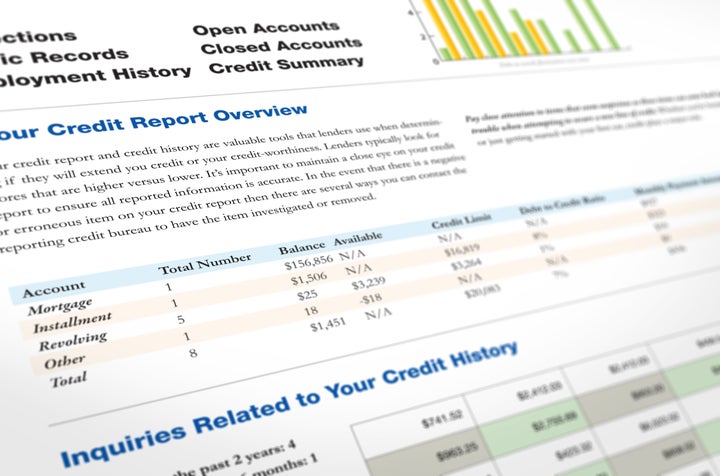
What’s the difference between a credit report and a credit score? We’re guessing that question doesn’t keep you up at night, but at some point you’ve wondered.
After all, your credit plays an important role in everything from borrowing money to getting an apartment. And when the matter comes up, it can be pretty darn confusing as to whether your credit report, credit score or some other mysterious factor is under consideration.
We’re here to break down the differences between your credit report and your credit score so you never have to wonder again.
What Is A Credit Report?
Let’s start with your credit report ― or rather, reports. That’s right, you actually have more than one.
That’s because three major credit bureaus collect data on your credit activity: Experian, Equifax and TransUnion. They track your behavior independently and detail their findings in their own separate reports.
So what kind of information is on a credit report? In addition to personally identifying data such as your name, address, date of birth and Social Security number, you’ll see details of the accounts you have with lenders and credit card companies.

A credit report should contain a list of all your revolving credit accounts (basically your credit cards) and your installment credit accounts (such as student loans, car loans and mortgages). The report will note the account number and lender, whether the account is open or closed, how much you owe, and whether the account is in good standing or has had missed payments.
Other negative items ― such as bankruptcies, foreclosures, liens and debts that have been sent to collection agencies ― will also be noted. Generally, those kinds of entries will remain on your reports for seven years, up to 10 in some cases. You’ll also see a list of credit inquiries from the past two years.
Because credit reports are managed by three different bureaus, there’s a chance they could contain slightly different information. It’s important to regularly review your credit reports to make sure there aren’t any discrepancies (more on that later).
What Is A Credit Score?
If you think of your credit reports as the homework you did in school, which show your progress over time, your credit score is like your final grade.
Credit scores are three-digit numbers that describe your behavior when borrowing and paying back money. The higher your score, the better, because it means lenders see you as a lower risk. People with high credit scores tend to get the lowest interest rates and best terms when they borrow money, while those who have bad credit tend to pay sky-high rates or don’t get approved for loans at all.

And like credit reports, you have more than one credit score. In fact, you can have dozens. Most credit scores, however, follow one of two models.
FICO Score: The Fair Isaac Corporation, or FICO, is a data analytics company that developed the FICO credit score nearly 30 years ago. The company employs a proprietary algorithm to come up with an overall score on you for each credit bureau, using that bureau’s credit report. The credit bureaus, who pay a licensing fee to FICO, then sell those scores to lenders.
Over the years, FICO has tweaked and expanded its score. Today, there are more than 60 versions, which can vary depending on the credit bureau and the particular scoring model.
FICO scores usually range between 300 and 850. According to Experian, a score above 740 is considered very good, while 800 or higher is exceptional. Ninety percent of lenders look at your FICO credit score when making lending decisions (according to FICO, anyway). So although there are other types of scores, your FICO score is generally the one you should care about.
VantageScore: The VantageScore was developed by the credit bureaus in 2006 as a competitor to FICO. Earlier versions of that score used a range of 501 to 990, but the latest, VantageScore 3.0, follows the same 300-850 range as FICO.
VantageScore credit scores serve more as information for borrowers, since lenders are less likely to rely on them, and they’re sometimes referred to as “educational” scores. Even so, VantageScore says that between July 2016 and June 2017, more than 2,200 financial institutions used more than 6 billion of its scores.
How Is A Credit Score Calculated?
Though there are many types of credit scores based on varying and secret formulas, they tend to consider the same general factors. Here’s how FICO says its scores are calculated:
Payment history (35 percent): Of all the factors that go into a credit score, payment history carries the most weight. Paying all your bills on time will strengthen your score, while missing payments will lower it. The later the payment, the more serious the impact.
Amounts owed (30 percent): The next most important factor is how much you owe or your credit utilization ratio, which divides your total debt by your total available credit. It’s a good idea to keep this ratio under 30 percent, otherwise your credit score can take a hit. That’s especially true in relation to credit cards and other revolving credit, which are weighted more heavily than installment loans.
Length of credit history (15 percent): Lenders like to see that you have a lot of experience handling credit, so the longer your credit history, the better. People who haven’t been using credit for very long might have what’s called a thin credit file, which can negatively affect their score.
New credit (10 percent): Having several accounts and loans can help your score, but only if you’ve opened them steadily over time. Too many applications for credit over a short period could be a sign that you’re struggling to handle your bills and thus can drag down your score.
Credit mix (10 percent): Lenders like to see that you can handle different types of credit. In addition to credit cards, having other kinds of loans, like a car loan or a personal loan, can help give your credit score a boost ― but only if they’re in good standing.
How To Monitor Your Credit Report And Score
Maintaining good credit is essential to your daily life, but clearly, there’s a lot to keep track of. Fortunately, there are some resources that can help.
To start, you should regularly review your credit reports for errors or potential fraud. Annualcreditreport.com is the only website that’s federally authorized to provide credit reports at no cost. However, you can access each report for free only once a year, so you might want to pull a different report every three or four months rather than requesting them all at once.
Unfortunately, your credit reports don’t include your credit score. And not too long ago, it was tough to get your FICO score for free. These days, however, it’s common for most major credit card issuers to provide monthly FICO scores to cardholders. In fact, more than 50 million people get their scores on their card statements.
Additionally, there are several free credit score sites that let you see your VantageScore. These include Credit Karma, Credit Sesame, WalletHub and Nerdwallet. The sites also provide free credit monitoring and alerts that can let you know about any changes to your accounts.
By tracking your credit score over time, you can get an idea of whether you’re heading in the right direction or might need to fix something. And if your score drops suddenly, you know something’s up.
Finally, when it comes to credit, there’s certainly nothing wrong with striving for perfection. But don’t get down on yourself if you’re nowhere near an 850 score. Understanding how your credit reports and scores work is a great first step in better managing your credit. And by following the guidelines above, especially paying your bills on time and keeping your balances low, you should see progress toward good credit in the long run.
